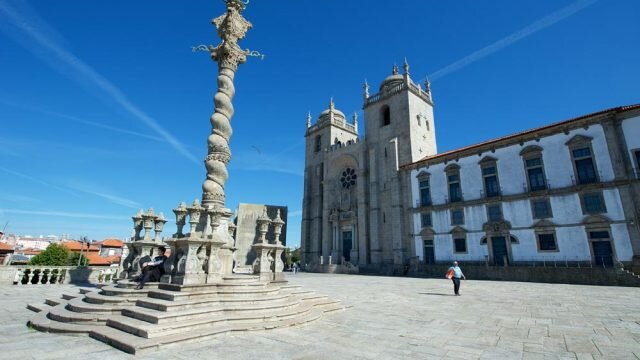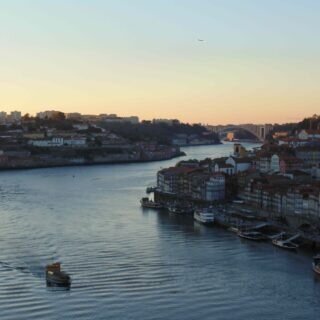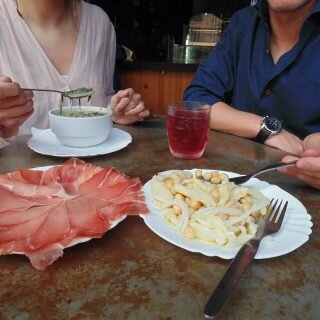Porto’s most ancient landmark: The Sé
The word Sé in Portuguese is perhaps what tells you the most about this monument. It is used as a reference for those Cathedrals that in served as the seat of power in the major lands during the earlier ages of our country, especially for those that were overseen by the Church, especially in the person of a bishop. So the foundation of the medieval city of Porto, in broad 11th century, is closely tied with the construction of its very own Sé. This story begins with Portugal’s first king, Dom Afonso Henriques, or more accurately with his mother, countess Teresa of Leon, who consigns the city to a French bishop, dom Hugo. This was a decisive moment for the city, as it marked the rupture of the ruling diocese (whose headquarters at that time was located in the city of Braga) and the role of Bishop dom Hugo in these events was pivotal, to the point of being given the honour of having one of the streets, that nowadays run around the cathedral itself, named after him. This paved the path for the independence of this once small city and its rise as one of the most important cities in Portugal up to this day.

A journey through history
The Sé is not just Porto’s largest and most important sanctuary but it is also an opportunity to travel back in time through all of the city’s history. The building itself is amalgamate of many projects that were designed through the course of time. The original project from the 12th Century is precisely the main body of the Cathedral, characterized by the simplicity of the Romanesque of the early Middle Ages and its sturdy walls that highlight yet another function this landmark had aside its obvious ecclesiastical role. In a time deeply marked by conflict, buildings such as this one served as a refuge in the event of a battle. For that reason the local populace established its sanctuary upon robust walls so as to repel its invaders, paved it with a few, miniscule windows, which rather than being used as a source of natural light indoors, were used as murder holes to shoot their enemies through and atop it all, they placed battlements all across the roof. Thus, the Sé was not only the city’s main temple but in its own way a fortress. A couple of hundred years later, in the 14th Century, a new age dawned upon Europe and the city. Porto had grown substantially as a port city for many merchants from all corners of Europe and all the way up from the north, Gothic imposed itself as the hype style of that time. It too would leave its mark upon the city’s sanctuaries, chief among them the Cathedral of Sé. Around that time a new cloister was erected right next to its predecessor (which can still be seen today from within this very space), paved with the typical Gothic-inspired pointed arches. Whilst in there, do not miss out on the small chapel of São João Evangelista, even though you may easily overlook it, it holds a window to the architecture of that time and one of the most esteemed treasures of this Cathedral: the tomb of João Gordo, knight of Malta and sheriff to king D. Dinis during the early 14th Century. Another relic of that time is the marvellous rose-shaped, stained glass window that sits just above the main entrance of the Cathedral. Hundreds of years later though, another drastic intervention occurs.

The Golden Age of Porto and the Sé
Ushered by the influx of wealth derived from growing commerce and the gold from Portugal’s colonies, the city of Porto enters one of the brightest periods of its history. The 18th Century marks a time of great expansion for the city and at the heart of it all is the Cathedral itself as one of the city’s most prominent landmarks. It is precisely one of the greatest names in the architecture of Porto that takes the lead on the intervention works to the Sé during this time. Nicolau Nasoni, the author of the Clérigos, one of the city’s most brilliant and renown monuments, is hired as painter to work a beautiful set of frescos that can be admired from within the altar or the sacristy. His intervention, however, would not stop there, he would design a fountain just outside the Cathedral, the Chafariz de São Miguel, the beautifully ornamented balcony that makes up its northern façade, known as the Galilé, and he would also design a new palace for the bishop over the original. The 18th Century would thus leave the mark of the Baroque, with all its splendour and exuberance, upon the Sé. Yet, there is one other structure within that greatly displays the rising wealth and power of the city and the Church: the Capela do Santíssimo Sacramento. Located to the left of the main altar, it is a small chapel, built a century earlier that contains one of the Cathedral’s most prized treasures, the Silver Altar. A majestic piece with highly detailed carvings of incalculable value, it came very close to its utter ruin, as a story tells us. In the beginning of the 19th Century, as the Napoleonic forces swept through Europe and Portugal in this particular case, they sowed death and destruction in their wake, pillaging the lands and stripping them of their fortunes, some of them located within holy buildings much like this one. The French soldiers would eventually make their way into Porto, and this altar would have met the same faith as with the many other plundered treasures, were it not for the intervention of a priest who had it entirely covered in lime so as to hide it from the looter’s frenzy.

The Sé of today
More recently in our city’s history the Cathedral would once more undergo a series of new modifications. In broad XX century, with the country smothered under the heel of a brutal dictatorship, the regime, in the name of a supposed glorification of Portugal’s history and tradition, would impose a new project for the city’s most important sanctuary. Outside of the Cathedral all of the surrounding area, composed of a dense network of housing that made up one of the city’s oldest residential areas, was completely razed to the ground and in its place a wide open terrace was built, so as to highlight the presence of the Sé, turning it into a sort of a beacon for all of the city. Another mark of this recent intervention is another structure we find in this very same place: the pillar at the very end of the terrace. Despite its ancient look about it, it is but a recreation of an illustration from the 18th Century, done precisely under the tutelage of this latter regime.
This is then the legacy of a space that has suffered continuous changes throughout the course of time, that like none other in the city, bear witness to its history and to all its unsettled moments.




